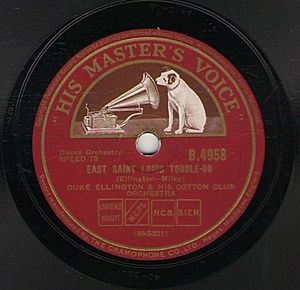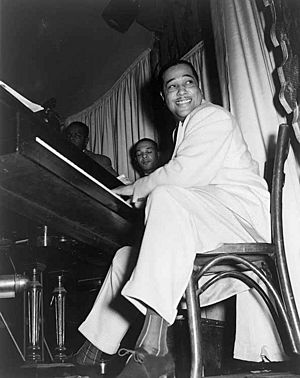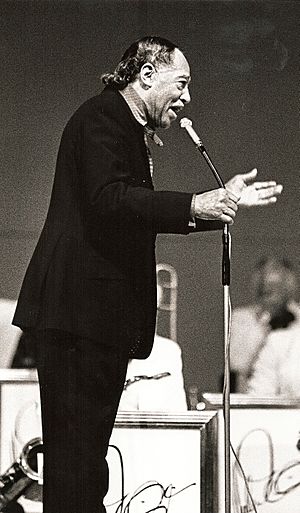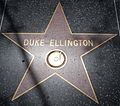Duke Ellington facts for kids
Quick facts for kids
Duke Ellington
|
|
|---|---|

Ellington around the 1940s
|
|
| Background information | |
| Birth name | Edward Kennedy Ellington |
| Born | April 29, 1899 Washington, D.C., U.S. |
| Died | May 24, 1974 (aged 75) New York City, U.S. |
| Genres | |
| Occupation(s) |
|
| Instruments | Piano |
| Years active | 1914–1974 |
| Associated acts | Billy Strayhorn |
Edward Kennedy "Duke" Ellington (born April 29, 1899 – died May 24, 1974) was an amazing American composer, pianist, and bandleader. He led his own jazz orchestra from 1923 until he passed away.
Born in Washington, D.C., Ellington moved to New York City in the mid-1920s. He became famous across the country because his orchestra often played at the Cotton Club in Harlem. In the 1930s, his band even toured Europe many times.
Some of the jazz musicians in Ellington's orchestra, like saxophonist Johnny Hodges, were considered among the best players ever. Ellington brought them together to create one of the most respected jazz orchestras in history. Many band members stayed with him for decades.
Ellington was a master at writing short songs, perfect for the three-minute records of his time. He wrote or helped write over a thousand songs! His huge collection of music is the biggest recorded jazz legacy by one person. Many of his songs have become famous jazz tunes, called "standards." He also recorded songs by his band members, like Juan Tizol's "Caravan". This song added a unique Spanish feel to big band jazz.
In the late 1930s, Ellington started working with composer and pianist Billy Strayhorn. This partnership lasted almost 30 years. Ellington called Strayhorn his "writing and arranging companion." Together, they created many long musical pieces, called suites, and also lots of shorter songs. For a few years, when Strayhorn first joined, Ellington's orchestra was at its very best. Bass player Jimmy Blanton and tenor saxophonist Ben Webster were briefly part of the band then.
After a quiet period, Ellington and his orchestra played at the Newport Jazz Festival in July 1956. This performance brought them back into the spotlight and led to regular world tours. Ellington recorded for most record companies of his time. He also performed in and wrote music for several films, and even composed a few stage musicals.
Ellington was a key figure in jazz history. Many experts call him "the most important composer of the genre." But Ellington himself liked to say his music was "beyond category." He saw it as a way to be free and called his music part of the larger idea of American Music. Ellington was known for how creatively he used his orchestra. He was also known for being a great speaker and having a strong personality. In 1999, he was given a special Pulitzer Prize for music after he had passed away.
Contents
Early Life and Learning
Ellington was born on April 29, 1899, in Washington, D.C. His parents, James Edward Ellington and Daisy Kennedy Ellington, both played the piano. Daisy mostly played popular songs, while James liked opera music. They lived with Daisy's parents in the West End neighborhood of D.C. Duke's father was born in North Carolina and moved to D.C. in 1886. Daisy Kennedy was born in Washington, D.C., and her parents had been enslaved. James Ellington worked making blueprints for the United States Navy.
When Edward was a child, his family worked hard to protect him from the unfair Jim Crow laws of that time. These laws created strict separation between Black and white people.
At age seven, Ellington started piano lessons. His mother made sure he was surrounded by polite women to teach him good manners and how to be elegant. His childhood friends noticed his calm, stylish way of dressing and acting. They thought he seemed like a young nobleman, so they started calling him "Duke." Ellington said his friend Edgar McEntee gave him the nickname. He thought Edgar felt that for them to be good friends, Duke needed a special title.
Even though Ellington took piano lessons, he was more interested in baseball. He remembered that "President Roosevelt (Theodore) would come on his horse sometimes, and stop and watch us play." Ellington went to Armstrong Technical High School in Washington, D.C. His first job was selling peanuts at baseball games for the Washington Senators team.
At fourteen, Ellington started sneaking into Frank Holiday's Poolroom. Hearing the pianists there made him love the instrument, and he began to take his piano studies seriously. He listened to many great piano players.
In the summer of 1914, Ellington worked at the Poodle Dog Café. There, he wrote his first song, "Soda Fountain Rag." He created the song by listening and playing, because he hadn't learned to read or write music yet. Ellington remembered, "I would play the 'Soda Fountain Rag' as a one-step, two-step, waltz, tango, and fox trot. Listeners never knew it was the same piece. I was established as having my own repertoire." In his book Music is my Mistress (1973), Ellington wrote that he missed more lessons than he attended. At the time, he didn't think piano was his main talent.
Ellington kept listening to and copying ragtime pianists in Washington, D.C., and also in Philadelphia and Atlantic City, where he vacationed. A music teacher named Henry Lee Grant gave him private lessons in music theory. With help from Washington pianist Oliver "Doc" Perry, Ellington learned to read sheet music, play like a professional, and improve his skills. He was also inspired by stride pianists like James P. Johnson and Luckey Roberts. Later in New York, he got advice from other famous musicians. He started playing at cafés and clubs around Washington, D.C. His love for music was so strong that in 1916, he turned down an art scholarship to the Pratt Institute in Brooklyn. He even left Armstrong Manual Training School, where he was studying commercial art, three months before graduating.
Career
Starting Out
From 1917, Ellington worked as a sign painter. He started putting together groups to play for dances. In 1919, he met drummer Sonny Greer, who encouraged Ellington to become a professional musician. Ellington used his sign-painting job to build his music business. If a customer asked him to make a sign for a dance, he would ask if they had music. If not, Ellington would offer to play. He also had a messenger job with the U.S. Navy and State departments, where he met many useful people.
As Ellington became a successful pianist, he moved out of his parents' home and bought his own. At first, he played in other bands. In late 1917, he formed his first group, "The Duke's Serenaders." He also managed the band's bookings. His first paid performance was at the True Reformer's Hall, where he earned 75 cents.
Ellington played all over the D.C. area and into Virginia for private parties and embassy events. His band included childhood friend Otto Hardwick on saxophone, Arthur Whetsel on trumpet, Elmer Snowden on banjo, and Sonny Greer on drums. The band did very well, playing for both African American and white audiences. This was unusual in the segregated society of that time.
When his drummer Sonny Greer was asked to join the Wilber Sweatman Orchestra in New York City, Ellington left his successful career in D.C. and moved to Harlem. He became part of the exciting Harlem Renaissance, a time when Black art and culture thrived. New dances like the Charleston became popular in Harlem, along with African American musical theater. After the young musicians left the Sweatman Orchestra to start their own group, they found a very competitive jazz scene. They played pool for money during the day and took any music jobs they could find. They met stride pianist Willie "The Lion" Smith, who helped them get started and gave them some money. They played at "rent-house parties" to earn money. After a few months, the young musicians felt discouraged and returned to Washington, D.C.
In June 1923, they played a job in Atlantic City, New Jersey, and another at the fancy Exclusive Club in Harlem. This led to a four-year job at the Hollywood Club (later called the Club Kentucky) starting in September 1923. This gave Ellington a strong base for his music. The group was first called Elmer Snowden and his Black Sox Orchestra and had seven members, including trumpeter James "Bubber" Miley. They later changed their name to The Washingtonians. Snowden left in early 1924, and Ellington became the bandleader.
Ellington then made eight records in 1924, and he was given credit for writing three of the songs, including "Choo Choo." In 1925, Ellington wrote four songs for Chocolate Kiddies, an all-African American show that introduced European audiences to Black music and performers. Duke Ellington and his Kentucky Club Orchestra grew to ten players. They created their own special sound with Ellington's unique arrangements, the lively rhythms of Harlem, and the exciting sounds from the band members' instruments. These included growling trombones, high-pitched trumpets, and bluesy saxophone solos. For a short time, the famous soprano saxophonist Sidney Bechet played with them.
The Cotton Club Years
In October 1926, Ellington made a deal with agent Irving Mills. Mills would get 45% of Ellington's future earnings. Mills was good at finding new talent. After recording a few songs from 1924 to 1926, Ellington's deal with Mills allowed him to record many more songs. Sometimes, he even recorded different versions of the same song. Mills often took credit as a co-composer. From the start, Mills arranged recording sessions for Ellington on almost every record label. This helped Ellington become very well known.
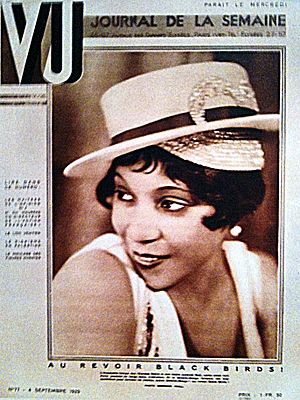
In September 1927, King Oliver turned down an offer to be the house band at Harlem's famous Cotton Club. The offer then went to Ellington after someone suggested him, and Mills set up an audition. Ellington had to make his band bigger, from six to eleven members, for the audition. The band finally started playing there on December 4. The Cotton Club had only white and wealthy customers, who came nightly to see the band. With weekly radio broadcasts, Ellington's band became famous across the country. At the Cotton Club, Ellington's group played all the music for the shows, which included comedy, dance, and music.
Even though trumpeter Bubber Miley was only in the orchestra for a short time, he had a big impact on Ellington's sound. Miley was one of the first to use a "growl" sound on his trumpet. This changed the band's sweet dance music to a hotter style, which people at the time called "Jungle Style." In October 1927, Ellington and his Orchestra recorded several songs with singer Adelaide Hall. One song, "Creole Love Call", became a huge hit around the world and was the first big success for both Ellington and Hall. Miley had written most of "Creole Love Call" and "Black and Tan Fantasy". Miley left the band before they became widely famous and sadly died in 1932 at age 29. But he greatly influenced Cootie Williams, who took his place.
In 1929, the Cotton Club Orchestra performed on stage for several months in Florenz Ziegfeld's Show Girl. This show also featured famous stars and music by George Gershwin. Ellington's film work began with Black and Tan (1929), a 19-minute film with an all-African American cast. He played the hero, "Duke." He also appeared in the film Check and Double Check in 1930. That year, Ellington and his Orchestra reached a new audience by performing with Maurice Chevalier. They also played at the Roseland Ballroom, a very famous dance hall. The Australian composer Percy Grainger was an early fan. He once wrote, "The three greatest composers who ever lived are Bach, Delius and Duke Ellington." Ellington's first time at the Cotton Club ended in 1931.
The Early 1930s
Ellington led his orchestra by playing the piano and using hand signals. He rarely used a stick to conduct. By 1932, his orchestra had six brass instruments, four reed instruments, and a rhythm section of four players. As a leader, Ellington was not strict. He kept his orchestra in line with charm, humor, praise, and smart ways of understanding people. He was a complex and private person, sharing his feelings only with his closest friends. He used his public image to keep attention away from himself.
Ellington signed a special recording deal with Brunswick in 1932 and stayed with them until late 1936.
As the Great Depression got worse, the music recording business faced big problems. Many artists lost their recording deals. Ivie Anderson became the main singer for the Ellington Orchestra in 1931. She sang on "It Don't Mean a Thing (If It Ain't Got That Swing)" (1932) and other songs. Radio helped Ellington stay famous as his orchestra started to tour. Other popular songs from this time include "Mood Indigo" (1930), "Sophisticated Lady" (1933), "Solitude" (1934), and "In a Sentimental Mood" (1935).
While Ellington's audience in the United States was mostly African American during this time, his orchestra had many fans overseas. They traveled to England and Scotland in 1933, as well as France and the Netherlands, before returning to New York. On June 12, 1933, the Duke Ellington Orchestra played for the first time in Britain at the London Palladium. Ellington received a huge cheer when he walked on stage. The British visit earned Ellington praise from serious music critics. This made Ellington more interested in writing longer musical pieces.
His longer songs had already started to appear. Ellington had written and recorded "Creole Rhapsody" as early as 1931. In 1935, after his mother passed away, he recorded "Reminiscing in Tempo," which was so long it took up four sides of a record. Symphony in Black (also 1935), a short film, showed his longer piece called 'A Rhapsody of Negro Life'. It featured Billie Holiday and won an Academy Award for Best Musical Short Subject. Ellington and his Orchestra also appeared in the films Murder at the Vanities and Belle of the Nineties (both 1934).
For his agent, Mills, all this attention was a huge success, as Ellington was now known worldwide. On the band's tour through the segregated South in 1934, they avoided some of the difficulties Black Americans faced by traveling in private railcars. These cars provided comfortable places to sleep, eat, and store equipment, helping them avoid the unfairness of segregated facilities.
However, competition grew stronger as swing bands like Benny Goodman's became very popular. Swing dancing became a huge trend, especially among white college students. The ability to dance to music drove record sales and bookings. Jukeboxes spread across the country, making swing music even more popular. Ellington's band could certainly play swing music, but their strengths were creating different moods, subtle sounds, and rich compositions. That's why he said, "jazz is music, swing is business."
Later 1930s
From 1936, Ellington started recording with smaller groups (like sextets with six players, or octets with eight) taken from his 15-member orchestra. He wrote songs specifically to show off a certain musician. For example, "Jeep's Blues" was for Johnny Hodges, and "Echoes of Harlem" was for Cootie Williams. In 1937, Ellington returned to the Cotton Club, which had moved to a new location in the city. That summer, his father died, and Ellington faced financial difficulties. However, his situation improved in the following years.
After leaving agent Irving Mills, he signed with the William Morris Agency. Mills, though, still recorded Ellington. Well-known songs continued to be recorded, like "Caravan" in 1937, and "I Let a Song Go Out of My Heart" the next year.
Billy Strayhorn joined Ellington in 1939. He was first hired to write song lyrics. Nicknamed "Swee' Pea" because of his gentle nature, Strayhorn quickly became a very important part of Ellington's team. Ellington was very fond of Strayhorn and always spoke highly of their teamwork. He called Strayhorn "my right arm, my left arm, all the eyes in the back of my head, my brain waves in his head, and his in mine." Strayhorn had a strong background in classical music. He not only wrote his own songs and lyrics but also arranged and improved many of Ellington's works. He became like a second Ellington. It was common for Strayhorn to step in for Duke, whether it was leading the band, rehearsing, playing the piano, or working in the recording studio. The decade ended with a very successful European tour in 1939, just as World War II was about to begin in Europe.
Ellington in the Early to Mid-1940s
Two musicians who joined Ellington at this time, Jimmy Blanton and Ben Webster, became very famous. Blanton was hired right away in late October 1939. He changed how the double bass was used in jazz, making it a solo instrument instead of just a rhythm instrument. Sadly, a serious illness forced him to leave by late 1941 after about two years. Ben Webster played with Ellington from 1939 to 1943. He was the orchestra's first regular tenor saxophonist and made the saxophone section bigger, with five players for the first time. He was greatly influenced by Johnny Hodges and often said Hodges taught him "how to play my horn." The two men sat next to each other in the orchestra.
Trumpeter Ray Nance joined, replacing Cootie Williams, who had left to join Benny Goodman. Nance also added the violin to the band, giving Ellington more musical colors to use. Recordings exist of Nance's first concert with the band on November 7, 1940, in Fargo, North Dakota. These recordings were first officially released in 1978 as Duke Ellington at Fargo, 1940 Live. They are some of the earliest live performances that still exist. Nance also sang sometimes. Herb Jeffries was the main male singer during this time (until 1943), and Al Hibbler (who replaced Jeffries in 1943) continued until 1951. Ivie Anderson left in 1942 for health reasons after 11 years, which was the longest time any of Ellington's singers stayed.
Ellington started recording for Victor again in 1940. Short, three-minute masterpieces continued to come from Ellington, Billy Strayhorn, Ellington's son Mercer Ellington, and other band members. Songs like "Cotton Tail", "Main Stem", "Harlem Air Shaft", and "Jack the Bear" are from this time. Strayhorn's "Take the "A" Train", a hit in 1941, became the band's theme song, replacing "East St. Louis Toodle-Oo". Ellington and his team wrote for an orchestra of unique voices, showing amazing creativity.
Ellington's long-term goal was to make jazz music longer than the three-minute limit he was so good at. While he had written and recorded some longer pieces before, these types of works now became a regular part of Ellington's music. In this, he was helped by Strayhorn, who had more training in classical music forms than Ellington. The first of these longer works, Black, Brown and Beige (1943), was about the history of African Americans, including slavery and the church. Black, Brown and Beige was first performed at Carnegie Hall on January 23, 1943. This started a series of annual Ellington concerts at that famous venue for the next four years. While some jazz musicians had played at Carnegie Hall before, no one had performed anything as detailed as Ellington's work. Unfortunately, a common pattern began: Ellington's longer works were generally not very well received by critics.
One exception was Jump for Joy, a full-length musical about African American identity. It first opened on July 10, 1941, in Los Angeles. Even though it had sold-out shows and good reviews, it only ran for 122 performances. Its subject matter didn't make it popular for Broadway. Despite this, a Broadway show of Ellington's Beggar's Holiday, his only musical play, opened on December 23, 1946.
A recording ban from 1942 to 1944, which led to musicians getting more money, greatly affected how well big bands, including Ellington's, could make money. Ellington's income as a songwriter ended up helping to pay for his orchestra. Even though he always spent a lot and earned a good income from the band, the band's earnings often just covered its costs. In 1943, Ellington asked Webster to leave because the saxophonist's personality made his bandmates nervous, and he often argued with Ellington.
After the War
Musicians joining the military and travel rules made it hard for big bands to tour. Also, dancing became subject to a new tax, which lasted for many years and affected club owners' choices. By the end of World War II, popular music was changing. People started listening more to singers like Frank Sinatra. Since it cost more to hire big bands, club owners found smaller jazz groups cheaper. Some of Ellington's new songs, like "Transblucency" (1946) with singer Kay Davis, didn't become as popular as the new singing stars.
Ellington kept going his own way through these big changes. While Count Basie had to break up his whole band and work as a smaller group for a while, Ellington was able to tour most of Western Europe from April to June 1950. The orchestra played 74 shows in 77 days. During the tour, Ellington didn't play his newer works. However, Ellington's long song, Harlem (1950), was being finished around this time. Ellington later gave the music score to President Harry S. Truman. Also, while in Europe, Ellington wrote music for a stage show by Orson Welles.
In 1951, Ellington lost some important band members: Sonny Greer, Lawrence Brown, and most notably, Johnny Hodges left to try other things. However, only Greer left permanently. Drummer Louie Bellson replaced Greer, and his song "Skin Deep" was a hit for Ellington. Tenor player Paul Gonsalves joined in December 1950 and stayed for the rest of his life, while Clark Terry joined in November 1951.
André Previn, a famous musician, said in 1952: "You know, Stan Kenton can stand in front of a thousand fiddles and a thousand brass and make a dramatic gesture and every studio arranger can nod his head and say, Oh, yes, that's done like this. But Duke merely lifts his finger, three horns make a sound, and I don’t know what it is!" However, by 1955, after three years of recording for Capitol, Ellington didn't have a regular recording contract.
Career Comes Back Strong
Ellington's performance at the Newport Jazz Festival on July 7, 1956, brought him back into the public eye. The song "Diminuendo and Crescendo in Blue" was made of two tunes the band had been playing since 1937. Ellington, who had suddenly stopped the band's planned performance because four key players were late, called for these two songs as midnight approached. He announced that the two pieces would be separated by a solo played by tenor saxophonist Paul Gonsalves. Ellington then led the band through the songs, with Gonsalves' amazing 27-chorus solo making the crowd go wild. This caused Ellington to play much longer than allowed, despite urgent requests from the festival organizer to finish the show.
The concert made international headlines. It led to one of only five Time magazine cover stories about a jazz musician. It also resulted in an album that became Ellington's best-selling record ever. Much of the music on the album was actually re-recorded the next day, with fake crowd sounds added, which wasn't told to the buyers. The real concert recording wasn't properly released until 1999. The renewed attention from the Newport show wasn't a total surprise. Johnny Hodges had returned the year before, and Ellington's work with Strayhorn had also started up again around the same time.
The original Ellington at Newport album was the first release in a new recording deal with Columbia Records. This brought several years of steady recording for Ellington.
In 1957, CBS (Columbia Records' parent company) showed a live TV production of A Drum Is a Woman, a musical story that received mixed reviews. Performances at the new Monterey Jazz Festival and other places gave Ellington chances to play live. A European tour in 1958 was also very popular. Such Sweet Thunder (1957), based on Shakespeare's plays, and The Queen's Suite (1958), dedicated to Britain's Queen Elizabeth II, were created because of the new energy from the Newport performance. The Queen's Suite, however, was not sold to the public at that time. The late 1950s also saw Ella Fitzgerald record her Duke Ellington Songbook album with Ellington and his orchestra. This showed that Ellington's songs were now considered classic American music.
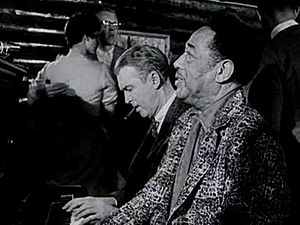
Around this time, Ellington and Strayhorn started writing music for films. The first was Anatomy of a Murder (1959), a courtroom movie directed by Otto Preminger. Ellington appeared in the film, leading a small band. Film experts say the music was a landmark. It was the first important Hollywood film music by African Americans that was not played by an on-screen band. The music avoided old stereotypes about jazz and didn't just follow the visuals. This was a new approach that came before the "New Wave" films of the 1960s. Ellington and Strayhorn, always looking for new musical ideas, also created suites for John Steinbeck's novel Sweet Thursday, Tchaikovsky's Nutcracker Suite, and Edvard Grieg's Peer Gynt.
Anatomy of a Murder was followed by Paris Blues (1961), which starred Paul Newman and Sidney Poitier as jazz musicians. For this work, Ellington was nominated for an Academy Award for Best Score.
In the early 1960s, Ellington started recording with artists who had been friendly rivals or younger musicians who played newer styles. The Ellington and Count Basie orchestras recorded together on the album First Time! The Count Meets the Duke (1961). When Ellington was between recording contracts, he made records with Louis Armstrong, Coleman Hawkins, and John Coltrane. He also took part in a session with Charles Mingus and Max Roach that created the Money Jungle album. He signed with Frank Sinatra's new record label, but that partnership didn't last long.
Musicians who had worked with Ellington before returned to the Orchestra: Lawrence Brown in 1960 and Cootie Williams in 1962.
Ellington said: "The writing and playing of music is a matter of intent.... You can't just throw a paint brush against the wall and call whatever happens art. My music fits the tonal personality of the player. I think too strongly in terms of altering my music to fit the performer to be impressed by accidental music. You can't take doodling seriously."
He was now performing all over the world and spent a lot of each year on tours overseas. Because of this, he formed new working relationships with artists from different countries, including Swedish singer Alice Babs and South African musicians Dollar Brand and Sathima Bea Benjamin.
Ellington wrote music for director Michael Langham's play of Shakespeare's Timon of Athens at the Stratford Festival in Canada. It opened on July 29, 1963.
Last Years
Ellington was considered for the Pulitzer Prize for Music in 1965. However, no prize was given that year. At 66 years old, he joked: "Fate is being kind to me. Fate doesn't want me to be famous too young." In 1999, he was given a special Pulitzer Prize after his death. It was given "to celebrate the 100th year of his birth, recognizing his musical genius, which beautifully showed the ideas of democracy through jazz and made a lasting contribution to art and culture."
In September 1965, he performed the first of his Duke Ellington's Sacred Concerts. He created a jazz Christian church service. Even though the work received mixed reviews, Ellington was proud of it and performed it many times. This concert was followed by two more of the same type in 1968 and 1973, known as the Second and Third Sacred Concerts. The Steinway piano he used to compose the Sacred Concerts is now at the Smithsonian's National Museum of American History. Like Joseph Haydn and Wolfgang Amadeus Mozart, Ellington led his orchestra from the piano. He always played the piano parts when the Sacred Concerts were performed.
Duke turned 65 in the spring of 1964 but showed no signs of slowing down. He continued to record important works like The Far East Suite (1966), New Orleans Suite (1970), The Afro-Eurasian Eclipse (1971), and the Latin American Suite (1972). Much of this music was inspired by his world tours. During this time, he recorded his only album with Frank Sinatra, called Francis A. & Edward K. (1967).
Among the last shows Ellington and his orchestra performed were one on March 21, 1973, at Purdue University, two on March 22, 1973, in Sturgis, Michigan, and the Eastbourne Performance on December 1, 1973. Ellington performed what is thought to be his final full concert at Northern Illinois University on March 20, 1974.
Personal Life
Ellington married his high school girlfriend, Edna Thompson (who died in 1967), on July 2, 1918, when he was 19. The next spring, on March 11, 1919, Edna gave birth to their only son, Mercer Kennedy Ellington.
Ellington's wife and son joined him in New York City in the late 1920s, but the couple soon separated for good. According to her obituary, she was "homesick for Washington" and went back home. In 1929, Ellington became partners with Mildred Dixon, who traveled with him, managed his music company, inspired songs like "Sophisticated Lady", and helped raise his son.
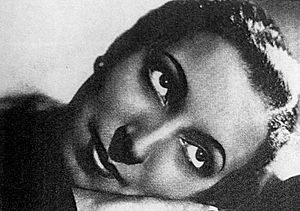
In 1938, he left his family (his son was 19) and moved in with Beatrice "Evie" Ellis, who worked at the Cotton Club. Their relationship was often difficult, but it continued even after Ellington met Fernanda de Castro Monte in the early 1960s. Ellington supported both women for the rest of his life.
Ellington's sister Ruth (1915–2004) later ran Tempo Music, his music publishing company. Ruth's second husband was the singer McHenry Boatwright, whom she met when he sang at her brother's funeral. As an adult, his son Mercer Ellington (who died in 1996) played trumpet and piano, led his own band, and worked as his father's business manager.
Ellington was a member of Alpha Phi Alpha, a fraternity, and was also a freemason.
Death
Ellington passed away on May 24, 1974, from problems caused by lung cancer and pneumonia. This was a few weeks after his 75th birthday. At his funeral, over 12,000 people attended at the Cathedral of St. John the Divine. Ella Fitzgerald summed up the sad day by saying, "It's a very sad day. A genius has passed."
He was buried in the Woodlawn Cemetery in the Bronx, New York City.
Legacy
Memorials
Many memorials have been created to honor Duke Ellington in cities like New York, Washington, D.C., and Los Angeles.
In Ellington's hometown, Washington, D.C., the Duke Ellington School of the Arts teaches talented students who want to work in the arts. In 1974, the city renamed the Calvert Street Bridge, built in 1935, as the Duke Ellington Bridge. Another school named after him is P.S. 004 Duke Ellington in New York.
In 1989, a bronze plaque was placed on the newly named Duke Ellington Building at 2121 Ward Place, NW. In 2012, the building's new owner asked artist Aniekan Udofia to paint a mural of Duke Ellington above the building's name. In 2010, the triangular park across the street from Duke Ellington's birthplace was named the Duke Ellington Park.
Ellington's home at 2728 Sherman Avenue, NW, where he lived from 1919 to 1922, has a bronze plaque.
On February 24, 2009, the United States Mint released a coin with Duke Ellington on it. This made him the first African American to appear alone on a circulating U.S. coin. Ellington is shown on the back (tails) side of the District of Columbia quarter. The coin is part of a program honoring the District and U.S. territories. It celebrates Ellington's birthplace in D.C. Ellington is shown on the quarter sitting at a piano, holding sheet music, with the words "Justice for All," which is D.C.'s motto.
In 1986, a United States postage stamp was issued featuring Ellington's picture.
Ellington spent his last years in a townhouse in Manhattan, at 333 Riverside Drive. His sister Ruth, who managed his publishing company, also lived there, and his son Mercer lived next door. After his death, West 106th Street was officially renamed Duke Ellington Boulevard.
A large memorial to Ellington, made by sculptor Robert Graham, was put up in 1997 in New York's Central Park. It is near Fifth Avenue and 110th Street, an intersection now called Duke Ellington Circle.
A statue of Ellington at a piano is at the entrance to UCLA's Schoenberg Hall.
The Essentially Ellington High School Jazz Band Competition and Festival is a famous yearly competition for talented high school bands. Started in 1996 at Jazz at Lincoln Center, the festival is named after Ellington because it focuses a lot on his music.
Tributes
After Duke died, his son Mercer took over leading the orchestra. He continued until he passed away in 1996. Like the Count Basie Orchestra, this "ghost band" kept releasing albums for many years. Digital Duke, credited to The Duke Ellington Orchestra, won a Grammy Award for Best Large Jazz Ensemble Album in 1988. Mercer Ellington had been handling all the business parts of his father's work for decades. Mercer's children continue to be involved with their grandfather's music.
Gunther Schuller wrote in 1989: "Ellington composed constantly until the very last days of his life. Music was truly his love; it was his whole life, and his dedication to it was unmatched and unchanging. In jazz, he was a giant among giants. And in 20th-century music, he may one day be recognized as one of the half-dozen greatest masters of our time."
Martin Williams said: "Duke Ellington lived long enough to hear himself called one of our best composers. And since his death in 1974, it has become common to see him named, along with Charles Ives, as the greatest composer we have produced, no matter the music style."
In 2002, scholar Molefi Kete Asante included Duke Ellington on his list of 100 Greatest African Americans.
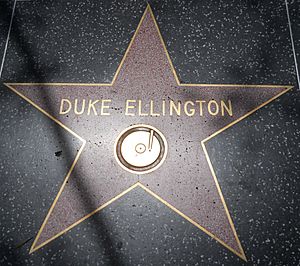
His songs have been played again by artists and musicians all over the world. They are a source of inspiration and a strong foundation for their performing careers.
- Dave Brubeck dedicated "The Duke" (1954) to Ellington. It became a classic song covered by others, including Miles Davis.
- Miles Davis created his half-hour sad song "He Loved Him Madly" as a tribute to Ellington one month after his death.
- Charles Mingus, who had been fired by Ellington many years before, wrote the tribute song "Duke Ellington's Sound Of Love" in 1974, a few months after Ellington's death.
- Stevie Wonder wrote the song "Sir Duke" as a tribute to Ellington. It appeared on his album Songs in the Key of Life released in 1976.
There are hundreds of albums dedicated to the music of Duke Ellington and Billy Strayhorn by famous and less known artists. Sophisticated Ladies, a musical show that won awards in 1981, used many songs from Ellington's collection. A second Broadway musical using Ellington's music, Play On!, opened in 1997.
Lost Music
Duke Ellington was one of many artists whose original music was reported to have been destroyed in the 2008 Universal Studios fire.
Awards and Honors
- 1960, Hollywood Walk of Fame, for his work in the recording industry.
- 1966, Grammy Lifetime Achievement Award.
- 1969, the Presidential Medal of Freedom, the highest award for a civilian in the U.S.
- 1971, an Honorary PhD from the Berklee College of Music.
- 1973, the Legion of Honour by France, its highest civilian honor.
- 1999, a special Pulitzer Prize after his death for his lifetime contributions to music and culture.
Grammy Awards
Ellington won 14 Grammy awards from 1959 to 2000. Three of these were given after he passed away. He received a total of 24 nominations.
| Duke Ellington Grammy Award History | ||||
|---|---|---|---|---|
| Year | Category | Title | Genre | Result |
| 1999 | Historical Album | The Duke Ellington Centennial Edition RCA Victor Recordings (1927–1973) |
Jazz | Won |
| 1979 | Best Jazz Instrumental Performance, Big Band | Duke Ellington At Fargo, 1940 Live | Jazz | Won |
| 1976 | Best Jazz Performance By A Big Band | The Ellington Suites | Jazz | Won |
| 1972 | Best Jazz Performance By A Big Band | Togo Brava Suite | Jazz | Won |
| 1971 | Best Jazz Performance By A Big Band | New Orleans Suite | Jazz | Won |
| 1971 | Best Instrumental Composition | New Orleans Suite | Composing/Arranging | Nominated |
| 1970 | Best Instrumental Jazz Performance – Large Group or Soloist with Large Group | Duke Ellington - 70th Birthday Concert | Jazz | Nominated |
| 1968 | Trustees Award | National Trustees Award - 1968 | Special Awards | Won |
| 1968 | Best Instrumental Jazz Performance – Large Group Or Soloist With Large Group |
...And His Mother Called Him Bill | Jazz | Won |
| 1967 | Best Instrumental Jazz Performance, Large Group Or Soloist With Large Group |
Far East Suite | Jazz | Won |
| 1966 | Bing Crosby Award - Name changed to GRAMMY Lifetime Achievement Award in 1982. | Bing Crosby Award - Name changed to GRAMMY Lifetime Achievement Award in 1982. | Special Awards | Won |
| 1966 | Best Original Jazz Composition | "In The Beginning God" | Jazz | Won |
| 1966 | Best Instrumental Jazz Performance – Group or Soloist with Group | Concert Of Sacred Music (Album) | Jazz | Nominated |
| 1965 | Best Instrumental Jazz Performance - Large Group Or Soloist With Large Group |
Ellington '66 | Jazz | Won |
| 1965 | Best Original Jazz Composition | Virgin Islands Suite | Jazz | Nominated |
| 1964 | Best Original Jazz Composition | Night Creature | Jazz | Nominated |
| 1964 | Best Jazz Performance – Large Group (Instrumental) | First Time! (Album) | Jazz | Nominated |
| 1961 | Best Instrumental Theme or Instrumental Version of Song | "Paris Blues" | Composing/Arranging | Nominated |
| 1961 | Best Sound Track Album or Recording of Score from Motion Picture or Television | Paris Blues (Motion Picture) (Album) | Music for Visual Media | Nominated |
| 1960 | Best Jazz Performance Solo or Small Group | Back To Back - Duke Ellington And Johnny Hodges Play The Blues | Jazz | Nominated |
| 1960 | Best Jazz Composition of More Than Five Minutes Duration | Idiom '59 | Jazz | Nominated |
| 1959 | Best Performance By A Dance Band | Anatomy of a Murder | Pop | Won |
| 1959 | Best Musical Composition First Recorded And Released In 1959 (More Than 5 Minutes Duration) |
Anatomy of a Murder | Composing | Won |
| 1959 | Best Sound Track Album – Background Score From A Motion Picture Or Television |
Anatomy of a Murder | Composing | Won |
| 1959 | Best Jazz Performance - Group | Ellington Jazz Party (Album) | Jazz | Nominated |
Grammy Hall of Fame
Recordings by Duke Ellington were added to the Grammy Hall of Fame. This special Grammy award started in 1973 to honor recordings that are at least 25 years old and are important for their quality or history.
| Duke Ellington: Grammy Hall of Fame Award | ||||
|---|---|---|---|---|
| Year Recorded | Title | Genre | Label | Year Inducted |
| 1932 | "It Don't Mean a Thing (If It Ain't Got That Swing)" | Jazz (single) | Brunswick | 2008 |
| 1934 | "Cocktails for Two" | Jazz (single) | Victor | 2007 |
| 1957 | Ellington at Newport | Jazz (album) | Columbia | 2004 |
| 1956 | "Diminuendo and Crescendo in Blue" | Jazz (single) | Columbia | 1999 |
| 1967 | Far East Suite | Jazz (album) | RCA | 1999 |
| 1944 | Black, Brown and Beige | Jazz (single) | RCA Victor | 1990 |
| 1928 | "Black and Tan Fantasy" | Jazz (single) | Victor | 1981 |
| 1941 | "Take the "A" Train" | Jazz (single) | Victor | 1976 |
| 1931 | "Mood Indigo" | Jazz (single) | Brunswick | 1975 |
Other Honors
| Year | Category | Notes |
|---|---|---|
| 2009 | Commemorative U.S. quarter | D.C. and U.S. Territories Quarters Program. |
| 2008 | Gennett Records Walk of Fame | |
| 2004 | Nesuhi Ertegun Jazz Hall of Fame at Jazz at Lincoln Center |
|
| 1999 | Pulitzer Prize | Special Citation |
| 1992 | Oklahoma Jazz Hall of Fame | |
| 1986 | 22¢ commemorative U.S. stamp | Issued April 29, 1986 |
| 1978 | Big Band and Jazz Hall of Fame | |
| 1973 | French Legion of Honour | July 6, 1973 |
| 1973 | Honorary Degree in Music from Columbia University | May 16, 1973 |
| 1971 | Honorary Doctorate Degree from Berklee College of Music | |
| 1971 | Honorary Doctor of Music from Howard University | |
| 1971 | Songwriters Hall of Fame | |
| 1969 | Presidential Medal of Freedom | |
| 1968 | Grammy Trustees Award | Special Merit Award |
| 1967 | Honorary Doctor of Music Degree from Yale University | |
| 1966 | Grammy Lifetime Achievement Award | |
| 1964 | Honorary degree, Milton College, Wisconsin | |
| 1959 | NAACP Spingarn Medal | |
| 1957 | Deutscher Filmpreis: Best Music | Award won for the movie Jonah with fellow composer Winfried Zillig |
| 1956 | DownBeat Jazz Hall of Fame inductee |
Images for kids
-
James Stewart and Ellington in Anatomy of a Murder (1959)
-
Ellington receiving the Presidential Medal of Freedom from President Nixon, 1969
-
Mercer referred to Mildred Dixon as his mother.
-
Star on the Hollywood Walk of Fame at 6535 Hollywood Blvd.
See also
 In Spanish: Duke Ellington para niños
In Spanish: Duke Ellington para niños


